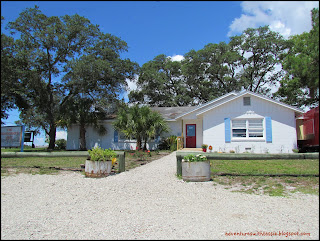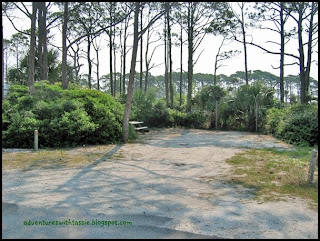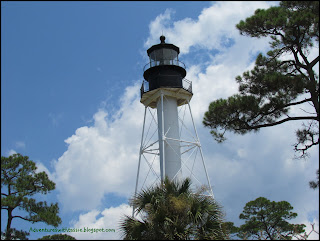The Cape St. George Lighthouse stood at the southern-most tip of “Little” St. George Island in the Gulf of Mexico. The island is 8 miles offshore of Apalachicola in the Florida Panhandle. Built in 1852, this 153-year-old veteran of hurricanes, wars, and erosion collapsed on October 21, 2005.
Its light was turned off during the Civil War so not to aid Yankee ships and it was not until August 1, 1865 that lighthouse keeper James Reilly relit the beacon. The lens suffered some damage during the war, but was replaced in 1888. In 1949, the Coast Guard installed an automated li
Beginning in 1992, storms and natural erosion had once again placed the lighthouse in peril. 1992's Hurricane Andrew pulled a major part of the beach area surrounding the Cape St. George Lighthouse back into the Gulf. The Coast Guard, realizing that the lighthouse might be lost, deactivated the light in 1994.
Before nature could build the beach sand back up around the lighthouse, Hurricane Opal struck in 1995. The resulting powerful tidal surge swept around the lighthouse, forcing it to move from its foundation. As the lighthouse settled into the sand, the iron circular staircase inside was torn from the walls, and the tower developed its lean. The oilhouse and the keeper's house were also severely damaged by Hurricane Opal. Photos of the Cape St. George Lighthouse, listing drunkenly at over 7°, became the unofficial graphic of the island. The entry door was boarded over, and “Danger!” signs were placed on the lighthouse. For a long time, this historical Florida Lighthouse seemed doomed.
Around 1995, Apalachicola Times editor John Lee began the "Save The Light" campaign. Contractor Bill Grimes,  using a backhoe, slowly excavated sand from around the base of the lighthouse on one side. After many days, the lighthouse settled into a vertical position. With the lighthouse level, he then drilled through the four-foot thick concrete walls at the base, inserting fiberglass reinforcing bars. A corrugated ring was placed around the base, and filled with concrete, forming an island around the base. But storms and erosion once again surrounded the Cape St. George Lighthouse with the Gulf of Mexico's swirling water. By Spring 2005 the lighthouse sat 20 feet out into the water, completely engulfed and the concrete platform Mr. Grimes poured had begun to see the effects of the wave action. On October 21, 2005 the lighthouse finally collapsed into the Gulf of Mexico.
using a backhoe, slowly excavated sand from around the base of the lighthouse on one side. After many days, the lighthouse settled into a vertical position. With the lighthouse level, he then drilled through the four-foot thick concrete walls at the base, inserting fiberglass reinforcing bars. A corrugated ring was placed around the base, and filled with concrete, forming an island around the base. But storms and erosion once again surrounded the Cape St. George Lighthouse with the Gulf of Mexico's swirling water. By Spring 2005 the lighthouse sat 20 feet out into the water, completely engulfed and the concrete platform Mr. Grimes poured had begun to see the effects of the wave action. On October 21, 2005 the lighthouse finally collapsed into the Gulf of Mexico.
Hurricane Dennis struck the Florida Panhandle on July 10, 2005 as a Category 3 hurricane. As the storm was compact and fast-moving, damage was less than had been predicted. Cape St. George Lighthouse, located roughly 100 miles from where Dennis made landfall, survived the storm intact. 2005 was a record year for hurricanes, but as no other hurricanes came close to the Cape St. George Lighthouse, it seemed the tower would survive another hurricane season. However, on October 21, years of stress on the leaning tower apparently became too much, as the lighthouse toppled into the gulf at 11:45 a.m. This dramatic photograph, taken the following morning by Debbie Hooper, shows the partially submerged tower.

The St. George Lighthouse Association, established in 2004 to "rescue the light", worked with the State of Florida DEP to salvage the pieces of the fallen light. The lighthouse was rebuilt at the center of St. George Island and opened to the public in December of 2008.

We had a great time exploring St. George Island and all the surrounding areas. I highly recommend you to come to this wonderful part of the Florida Panhandle and enjoy the beautiful beaches, gorgeous sunsets/sunrises and incredible food!


































































